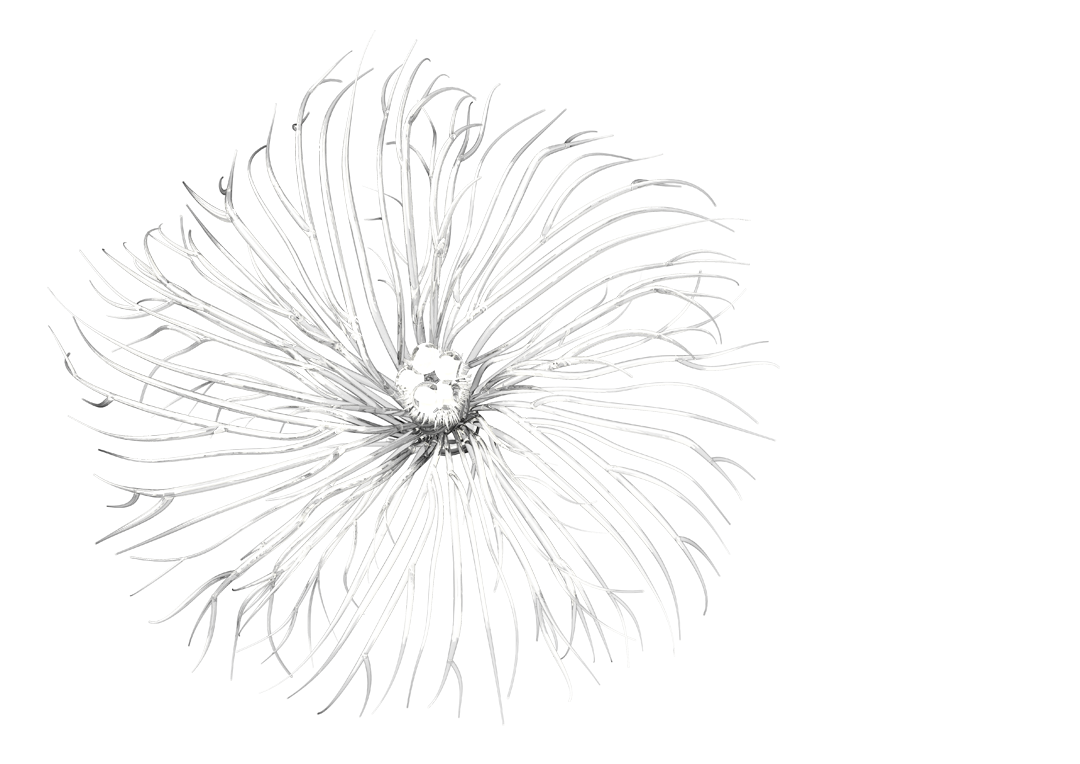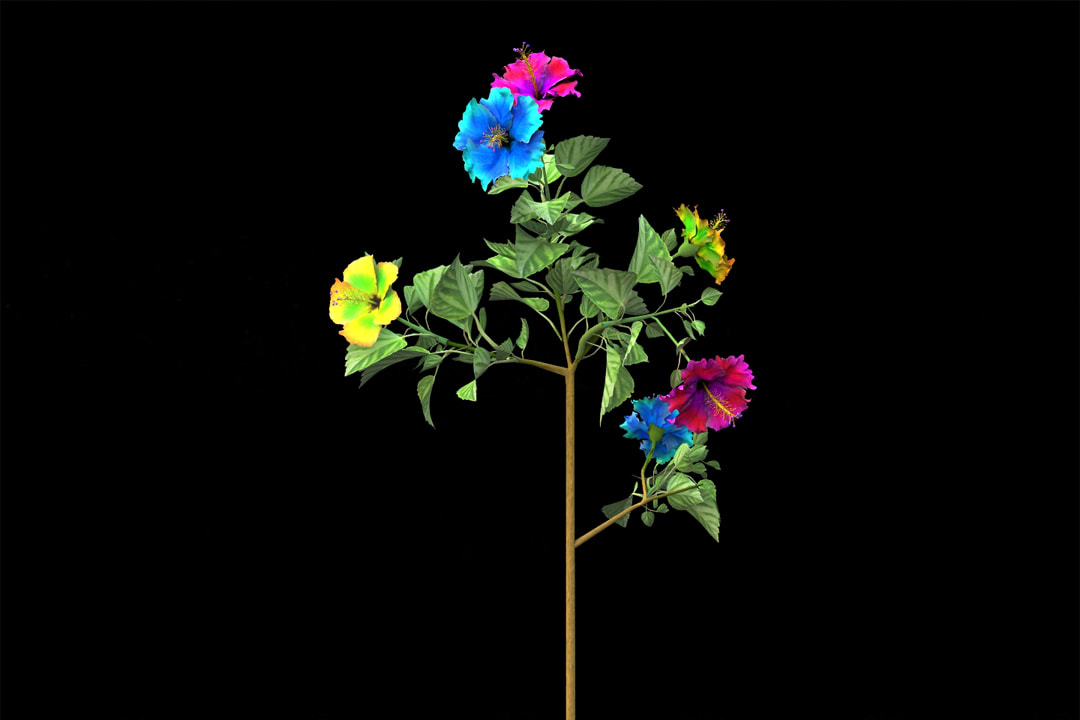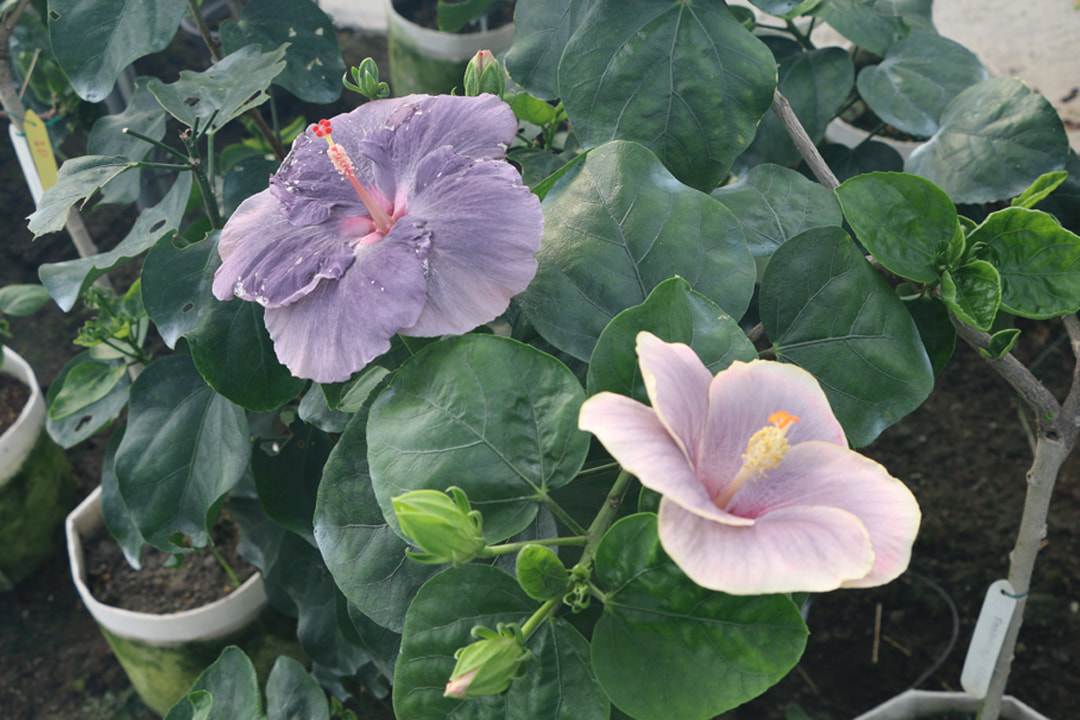Blooming Flowers, Flourishing Fortunes
花開富貴
2016-2019
Flowers,Soil,TV
花卉,泥土,電視
Dimensions variable
裝置依場域而定
花卉,泥土,電視
Dimensions variable
裝置依場域而定
This project came to shape during the Arts-in-Residence in Neng Sheng Xing factory (Tainan), where I attempted to cultivate flowers that show the pattern of a Taiwanese traditional calico fabric and hoped to probe into local history of its industry development and self-identity seeking.
The printed cloth featured in this project was obtained from my grandmother’s hand-made clothes for me in my childhood at Tainan. She was used to be a tailor and owned a shop combining a tailor working space with a cloth house. Her shop was in between a lace factory and a food processing factory; it’s quite interesting for me to found the fact that these two factories happened to be deeply involved into the developing history of Neng Sheng Xing factory when it was still called “Yuan Fa textile factory” before transforming into an international art space nowadays.
These facts motivated me to take the textile industry history around the Neng Sheng Xing’s neighborhood as the project’s axis, and therefore, I decided to find some flower-patterned calico fabric among the street here. I found that a kind of low-priced flower-patterned cotton calico fabric was used to be mass-produced in this neighborhood. Even before advanced Japanese textile equipment was imported into Taiwan, the local textile factory owners had attempted to refer to existing foreign calico fabric to make their own design, and these Taiwan-made calico fabric have been widely used in daily commodities, such as: bamboo hat, for instance. After all these long years of textile technology development, Taiwan still conserves the flower-patterned calico fabric as one of the textile industry’s traditional item.
The pattern of the calico fabric my grandmother had used for making my clothes was probably not the factory owners’ hand-designed one mentioned above; however, it might be another variant manufactured by other local factories. After the field research on the streets, I have asked for the assistance of the Floriculture Research Office of the Agricultural Research and Extension Station; the staff analyzed the flower pattern on the calico fabric and inferred a possible breed of the flower. And finally, with another flower breeding amateur’s assistance, the cultivation of the flower out of the calico fabric was achieved eventually.
(This is a rough translation of the original in Chinese)
The printed cloth featured in this project was obtained from my grandmother’s hand-made clothes for me in my childhood at Tainan. She was used to be a tailor and owned a shop combining a tailor working space with a cloth house. Her shop was in between a lace factory and a food processing factory; it’s quite interesting for me to found the fact that these two factories happened to be deeply involved into the developing history of Neng Sheng Xing factory when it was still called “Yuan Fa textile factory” before transforming into an international art space nowadays.
These facts motivated me to take the textile industry history around the Neng Sheng Xing’s neighborhood as the project’s axis, and therefore, I decided to find some flower-patterned calico fabric among the street here. I found that a kind of low-priced flower-patterned cotton calico fabric was used to be mass-produced in this neighborhood. Even before advanced Japanese textile equipment was imported into Taiwan, the local textile factory owners had attempted to refer to existing foreign calico fabric to make their own design, and these Taiwan-made calico fabric have been widely used in daily commodities, such as: bamboo hat, for instance. After all these long years of textile technology development, Taiwan still conserves the flower-patterned calico fabric as one of the textile industry’s traditional item.
The pattern of the calico fabric my grandmother had used for making my clothes was probably not the factory owners’ hand-designed one mentioned above; however, it might be another variant manufactured by other local factories. After the field research on the streets, I have asked for the assistance of the Floriculture Research Office of the Agricultural Research and Extension Station; the staff analyzed the flower pattern on the calico fabric and inferred a possible breed of the flower. And finally, with another flower breeding amateur’s assistance, the cultivation of the flower out of the calico fabric was achieved eventually.
(This is a rough translation of the original in Chinese)
這個計畫發展自台南的能盛興國際藝術村的駐村期間,我試圖培育出一張碎花布裡的花卉,並且透過這個培育計畫討論當地產業發展與尋找自我認同的歷史。
這張花布來自於我還是個孩子時在台南生活所穿的手工衣服,我的祖母為我製造了這件衣服,祖母是一名裁縫,擁有一間裁縫工作室與布莊合併的店鋪,店鋪位置恰好在蕾絲工廠與食品工廠之間。有趣的是,這兩間工廠的過去恰恰與能盛興這棟建築還沒變成國際藝術村之前,還被稱為「源發紡織廠」的產業歷史息息相關。
於是我以能盛興國際藝術村所在街區的紡織產業歷史為主軸,尋找一些花卉圖案的布料,後來我發現這個街區在過去曾經大量生產過一種廉價的碎花棉布,在日本的紡織機械尚未進入台灣之前,這些由紡織廠老闆自行設計,模仿國外花布圖案的棉布被廣泛地應用在生活用品之中,如,斗笠。這些使用廉價 碎花布的生活用品經過漫長的時間,在已經擁有優良布料印製技術的今日依然保持了使用碎花布的傳統。
祖母為我製作的衣服所使用的碎花布可能不是過去紡織廠老闆親手繪製的廉價花棉布,但極有可能是某間紡織廠模仿花卉圖案的變體,在這個計畫之中,我請農業改良場的花卉實驗室協助,分析了這張花布上可能的花卉品種,並且請一名花卉育種的玩家協助培育出花布上的花卉。
這張花布來自於我還是個孩子時在台南生活所穿的手工衣服,我的祖母為我製造了這件衣服,祖母是一名裁縫,擁有一間裁縫工作室與布莊合併的店鋪,店鋪位置恰好在蕾絲工廠與食品工廠之間。有趣的是,這兩間工廠的過去恰恰與能盛興這棟建築還沒變成國際藝術村之前,還被稱為「源發紡織廠」的產業歷史息息相關。
於是我以能盛興國際藝術村所在街區的紡織產業歷史為主軸,尋找一些花卉圖案的布料,後來我發現這個街區在過去曾經大量生產過一種廉價的碎花棉布,在日本的紡織機械尚未進入台灣之前,這些由紡織廠老闆自行設計,模仿國外花布圖案的棉布被廣泛地應用在生活用品之中,如,斗笠。這些使用廉價 碎花布的生活用品經過漫長的時間,在已經擁有優良布料印製技術的今日依然保持了使用碎花布的傳統。
祖母為我製作的衣服所使用的碎花布可能不是過去紡織廠老闆親手繪製的廉價花棉布,但極有可能是某間紡織廠模仿花卉圖案的變體,在這個計畫之中,我請農業改良場的花卉實驗室協助,分析了這張花布上可能的花卉品種,並且請一名花卉育種的玩家協助培育出花布上的花卉。
Model of Flower Breeding
Process
Exhibition
GAG Moderne inaugurates the "Psycho exhibition"
New Delhi Times Burean on Sep. 4, 2019
The inaugural ceremony of the "Psycho Exhibition" at GAG Moderne turned into a huge success
New Delhi Times Burean on Sep. 2, 2019
GAG Moderne Art gallery to hold one of a kind Exhibition titled "Psycho"
New Delhi Times Burean on Aug. 26, 2019
Hometown and Ideal Are Far Away- A Long journey of Pursuing Utopia, Exhibition “Nowhere We meet”
鄉與舊俱遠:《無何有鄉》,追尋烏托邦的漫長旅程
Website of Taishin Bank Foundation for Arts and Culture, Write in Chinese, Author LAI Pei-Jyun Dec. 11, 2017
台新銀行文化藝術基金會網站 賴佩君
台新銀行文化藝術基金會網站 賴佩君
Now, Here We Meet- Exhibition “Nowhere We Meet” and TCAA Online Curatorial Practice
在此,我們相遇 《無何有鄉》與線上策展
Website of Global Art Criticism, Write in Chinese, Author CHEN Si Dec. 4, 2017
全球藝評網站 陳晞
全球藝評網站 陳晞














